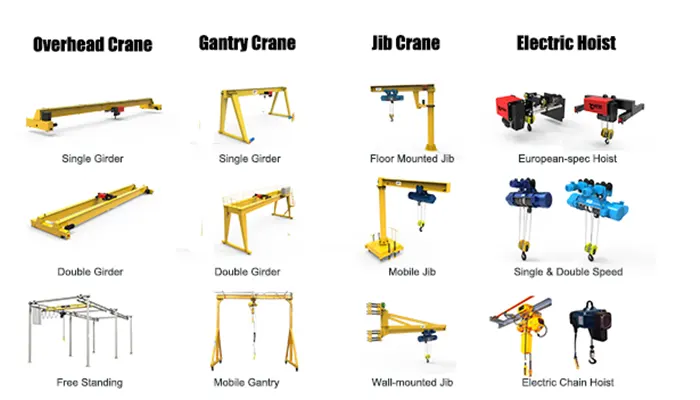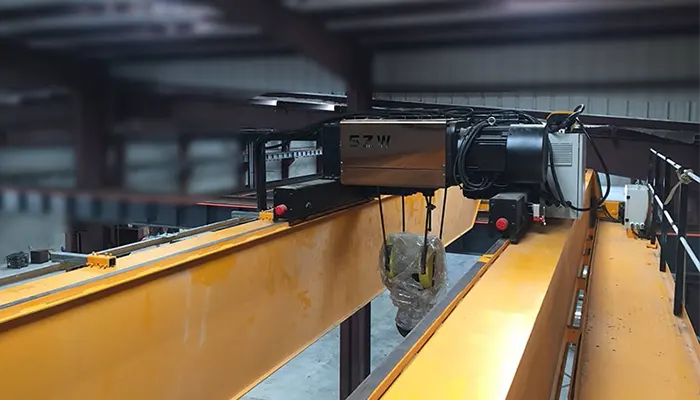Space Planning for Overhead Cranes: Headroom & Lifting Height
Overhead cranes are indispensable tools in modern industrial operations, providing the ability to move heavy loads with precision and efficiency. Proper space planning is crucial to ensure that these cranes operate effectively and safely. Central to this planning are the concepts of headroom and lifting height, which significantly impact the crane's performance and the facility's layout. This article delves into understanding these aspects across various crane capacities, providing a comprehensive guide to optimizing space for overhead cranes.
The Basics of Overhead Cranes

Types of Overhead Cranes
Overhead cranes come in several varieties, each suited to different applications and facility types:
- Bridge Cranes: These are commonly used in large industrial settings and consist of two main girders that span the width of the work area. The hoist moves along the bridge, allowing for efficient load handling across the span.
- Gantry Cranes: These cranes have a similar structure to bridge cranes but are supported by legs that run on wheels or tracks. They are ideal for outdoor use or areas with limited overhead space.
- Jib Cranes: Jib cranes feature a horizontal arm (jib) that extends from a vertical column. They are perfect for applications requiring a smaller operational radius and are often used in assembly lines and maintenance areas.
- Custom Cranes: Tailored to specific requirements, these cranes can be designed to meet unique space constraints or specialized load handling needs.
Components of Overhead Cranes
Understanding the components of overhead cranes helps in planning their space requirements:
- Bridge Girder: The main horizontal beam that supports the hoist and trolley.
- Hoist: The mechanism responsible for lifting and lowering the load.
- End Trucks: These are mounted on either end of the bridge girder and allow the crane to travel along its tracks.
- Trolley: Moves along the bridge girder and supports the hoist.
Understanding Crane Capacities
Crane capacity refers to the maximum load a crane can handle safely. Key terms include:
- Load Capacity: The maximum weight the crane can lift.
- Safe Working Load (SWL): The maximum load that should be applied to the crane during operation.
- Duty Cycle: The frequency and duration of crane use, affecting its operational lifespan and maintenance needs.
Headroom Requirements for Overhead Cranes

Definition and Importance
Headroom refers to the vertical clearance between the highest point of the crane and the lowest part of the ceiling or any overhead structure. This space is essential for several reasons:
- Safe Operation: Adequate headroom ensures that the crane can operate effectively without hitting overhead obstructions. This clearance is vital to prevent damage to the crane and ensure safe lifting and lowering of loads.
- Efficient Load Handling: Sufficient headroom allows the crane to lift loads to their maximum height, which is crucial for tasks requiring precise positioning or handling of large components.
- Maintenance and Safety: Adequate headroom provides enough space for maintenance personnel to perform inspections, repairs, and routine maintenance without risk. It also contributes to overall safety by preventing accidents caused by insufficient clearance.
- Operational Flexibility: With adequate headroom, cranes can accommodate a wider range of loads and operational scenarios, increasing their versatility and efficiency in various industrial settings.
Calculating Headroom Requirements
To ensure that your crane has sufficient headroom, follow these steps:
Measuring Headroom
- Determine the Clearance Distance: Measure from the floor or work surface to the lowest point of any overhead obstruction, including beams, ceilings, or other structural elements.
- Account for Crane Components: Consider the height of the crane's components, such as the hoist, trolley, and bridge girder, which will affect the required headroom.
Factors Affecting Headroom
- Crane Type: Different types of cranes require varying amounts of headroom. For example, a bridge crane typically requires more headroom than a jib crane.
- Load Size: Heavier loads often require larger hoists and longer bridge girders, which can increase the headroom needed.
- Height of the Hoist: The design and size of the hoist impact the headroom requirement. A larger hoist will need more clearance.
Case Study
Consider a bridge crane used in an industrial facility. For a typical bridge crane, the headroom requirement can vary based on the crane's capacity and design:
- Low Capacity Cranes (1 ton – 10 tons): A 1-ton bridge crane might require around 8 feet of headroom. This is sufficient for handling lighter loads and allows for more compact design.
- Medium Capacity Cranes (15 tons – 30 tons): A 20-ton bridge crane typically needs up to 15 feet of headroom. This additional clearance accommodates larger hoists and bridge girders, providing the necessary space for efficient operation.
- High Capacity Cranes (40 tons and above): A 50-ton bridge crane often requires 20 feet or more of headroom. The larger size of the crane, combined with the need for more substantial components, necessitates greater vertical clearance to ensure safe and effective operation.
Headroom for Different Capacities
Low Capacity Cranes (1 ton – 10 tons)
For low capacity cranes, the headroom requirement is generally less due to the smaller size of the components. For example:
- 1-Ton Cranes: These cranes often need about 8 feet of headroom. The reduced headroom requirement is due to the smaller hoist and bridge girder, making them suitable for facilities with lower vertical clearance.
- 5-Ton Cranes: Typically require around 10 feet of headroom, accommodating slightly larger hoists and components compared to the 1-ton cranes.
Medium Capacity Cranes (15 tons – 30 tons)
Medium capacity cranes demand more headroom to accommodate their larger size and more complex mechanisms:
- 15-Ton Cranes: Usually require around 12 to 15 feet of headroom. This provides enough clearance for the hoist and bridge girder, allowing for efficient operation and load handling.
- 20-Ton Cranes: Typically need up to 15 feet of headroom to manage larger loads and ensure safe operation.
High Capacity Cranes (40 tons and above)
High capacity cranes require significant headroom due to their size and complexity:
- 40-Ton Cranes: Often need around 18 to 20 feet of headroom. The larger size of the crane and its components necessitates substantial clearance to operate effectively.
- 50-Ton Cranes: Can require more than 20 feet of headroom. This allows for the large hoist and bridge girders, ensuring that the crane can handle heavy loads without obstruction.
In conclusion, understanding and planning for headroom requirements is essential for optimizing crane operation and safety. By accurately measuring and considering factors such as crane type, load size, and hoist height, facilities can ensure that their cranes operate effectively and safely within the available space.
Lifting Height Considerations
Definition and Importance
Lifting height refers to the maximum vertical distance the crane can lift a load. This dimension affects the crane's ability to handle various tasks and the types of loads it can manage.
Calculating Lifting Height
To measure lifting height:
- Measuring Lifting Height: Determine the maximum distance from the load's resting position to the highest point the crane can lift it.
- Factors Affecting Lifting Height: Include the crane's design, hoist mechanism, and load size.
- Case Study: A 10-ton gantry crane may have a lifting height of 12 feet, while a 30-ton crane might offer up to 20 feet of lifting height.
Lifting Height for Different Capacities
- Low Capacity Cranes (1 ton – 10 tons): These cranes usually have a lifting height ranging from 10 to 15 feet.
- Medium Capacity Cranes (15 tons – 30 tons): Typically offer a lifting height of 15 to 25 feet, depending on the crane's design.
- High Capacity Cranes (40 tons and above): These cranes provide lifting heights that can exceed 30 feet, accommodating larger and heavier loads.
Space Planning for Overhead Cranes
Key Considerations
Effective space planning involves:
- Layout and Design: Optimizing the crane’s position to ensure efficient operation and minimal interference with other equipment.
- Safety and Accessibility: Ensuring that there is enough clearance for safe operation and maintenance.
- Maintenance and Operation: Designing the layout to facilitate easy access for maintenance and smooth operational flow.
Designing for Optimal Headroom and Lifting Height
Balancing headroom and lifting height involves:
- Balancing Headroom and Lifting Height: Ensuring that there is sufficient headroom for the crane to operate at its full lifting height.
- Custom Solutions for Unique Spaces: Designing cranes with adjustable components or custom features to fit specific facility requirements.
- Case Study: In an automotive plant with limited headroom, a custom gantry crane with a low profile and adjustable lifting height was installed to meet operational needs.
Impact of Facility Type on Space Planning
Different facilities have unique space planning requirements:
- Manufacturing Facilities: Often require cranes with high lifting heights and substantial headroom to handle large components.
- Warehouses: Typically need cranes with moderate headroom and lifting heights, suitable for managing inventory and materials.
- Automotive Plants: Demand cranes with specific capacities and adjustable heights for handling vehicle parts and assemblies.
- Aerospace and Marine Industries: Require cranes with high capacities and precise headroom measurements to manage large and delicate components.
Challenges and Solutions
Common Challenges in Space Planning
- Limited Headroom: Can restrict crane operation and increase the risk of collisions with overhead structures.
- Inadequate Lifting Height: Can limit the types of loads that can be handled and impact operational efficiency.
Solutions and Best Practices
- Upgrading Crane Systems: Implementing cranes with adjustable headroom and lifting heights.
- Adjusting Facility Layout: Redesigning the facility layout to accommodate crane requirements.
- Implementing Custom Crane Designs: Tailoring cranes to fit specific space constraints and operational needs.
Future Trends in Crane Design and Space Planning
Technological Advances
- Innovations in Crane Design: Advances in materials and design techniques are leading to more efficient and flexible crane systems.
- Advanced Control Systems: Modern control systems enhance the precision and safety of crane operations.
Future Space Planning Considerations
- Trends in Facility Design: Increased emphasis on flexible and adaptable spaces that can accommodate evolving crane technologies.
- Integration with Automation: The rise of automated systems requires cranes that can seamlessly integrate with other automated equipment.
Effective space planning for overhead cranes is crucial for optimizing operations and ensuring safety. Understanding the concepts of headroom and lifting height across different crane capacities enables facility managers to design efficient and functional layouts. By addressing challenges and adopting best practices, facilities can enhance their crane operations and adapt to future trends in crane design and technology.




